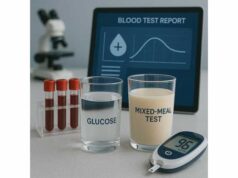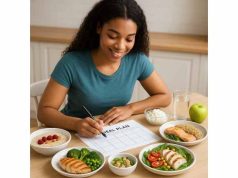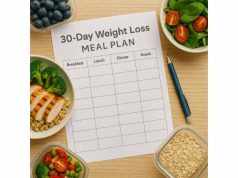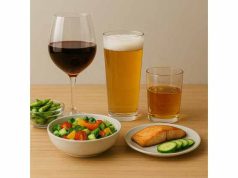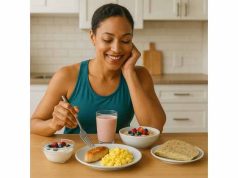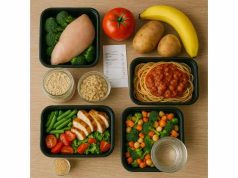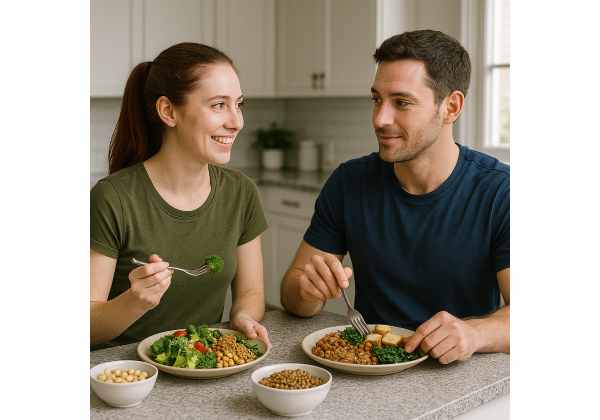
Losing weight on a vegetarian diet is absolutely possible when you center meals on protein, fiber, and smart portions. This 7-day plan shows you how to build filling plates with tofu, eggs, dairy, legumes, and grains so you stay satisfied while trimming calories. You will find clear protein targets, a full week of menus, and flexible templates you can repeat. If you want a refresher on setting daily energy and macro targets first, skim our concise guide to calorie and macro basics, then come back to put those numbers to work with easy, repeatable meals.
Table of Contents
- Does a vegetarian high-protein plan work?
- Vegetarian high-protein targets per day
- 7-day vegetarian high-protein menu
- High-protein vegetarian breakfasts
- Lunch and dinner templates
- Snacks, meal prep, and budget
- Supplements, safety and troubleshooting
- Frequently Asked Questions
Does a vegetarian high-protein plan work?
A well-planned vegetarian diet can drive fat loss as effectively as omnivorous plans when two levers are in place: sufficient protein and consistent calorie control. Protein is your anchor. It boosts satiety, preserves lean mass in a deficit, and raises diet-induced thermogenesis slightly compared with carbs or fat. When your day includes protein at every meal—ideally 25–40 grams—you stay fuller between meals and find it easier to protect the calorie deficit that leads to steady weight change.
Vegetarian diets sometimes struggle with protein density because many plant staples (grains, beans, nuts) also carry moderate calories from carbs or fats. The solution is strategic pairing. Tofu, tempeh, seitan, eggs, Greek yogurt, cottage cheese, and protein powder give you concentrated protein with fewer calories per serving. Beans and lentils then play a supporting role for fiber and minerals rather than being asked to carry the entire protein load alone.
Satiety comes from more than protein. Vegetables, fruit, soups, and yogurt add water and volume for few calories; intact whole grains and legumes add viscous fiber that slows digestion. This volume effect means a vegetarian plate can feel generous even at 1500–1800 calories. If you want a step-by-step view of how calorie balance drives results and how to set a reasonable weekly pace, see our practical guide to safe weight loss steps.
What results can you expect? With a 300–600 calorie daily deficit, most people see 0.25–0.75 kg (0.5–1.5 lb) per week on average, with normal fluctuations from glycogen and water. Progress is steadier when you eat protein with each meal, keep beverages low in calories, and choose fiber-rich sides first. The plan below shows exactly how to translate those principles into a week of satisfying vegetarian meals.
Common stumbling blocks include under-eating protein at breakfast, building lunches that are grain-heavy and light on protein, and relying on snack foods that add calories without meaningful satiety. You will avoid those traps by front-loading protein, using repeatable templates, and keeping quick protein options on hand (yogurt cups, baked tofu, eggs, pre-cooked lentils, canned beans, and a neutral protein powder).
Above all, think in patterns, not perfection. A vegetarian high-protein plan works when it is simple enough to repeat, flexible enough to fit your tastes, and balanced enough to keep hunger predictable.
Vegetarian high-protein targets per day
For weight loss with muscle retention, most adults do well with 1.6–2.2 g of protein per kilogram of body weight per day (0.7–1.0 g per pound). At 70 kg (154 lb), that is 110–155 g protein daily. If you are heavier, start near the lower end of the range and adjust by hunger and training load.
Meal distribution that keeps you full
- Breakfast: 25–40 g
- Lunch: 30–40 g
- Dinner: 30–40 g
- Snack(s): 10–30 g (as needed to hit your total)
Spreading protein across the day produces steadier satiety and supports muscle protein synthesis better than saving it all for dinner. In practice, this means anchoring breakfast with Greek yogurt or eggs, lunch with tofu, tempeh, or cottage cheese, and dinner with tofu, seitan, or a lentil-based dish.
Calorie targets that match your goal
- Many smaller, active women cut well at 1500–1700 calories; larger or more active individuals often do better at 1700–2000+.
- Use your personal energy target and adjust weekly by outcome and how hungry you feel mid-afternoon and late evening.
- Keep fiber in the 25–35 g/day range for regularity and fullness.
Protein quality on a vegetarian diet
- Dairy and eggs: high-quality, complete protein with excellent leucine content for muscle repair.
- Soy (tofu, tempeh, edamame): complete protein, versatile across cuisines.
- Seitan: very high protein per calorie, but gluten-based.
- Legumes and grains: together form a complete amino acid profile; keep portions measured to stay within calories.
- Protein powders: whey, casein, or plant blends (e.g., pea plus rice) help you “top up” on busy days.
Practical formula
- Set your protein target (e.g., 130 g/day).
- Assign ~35 g to each main meal and ~25 g to snacks as needed.
- Build meals using a “protein first” approach—choose the protein, then add vegetables, then add starches or fats to meet calories.
For deeper detail on setting daily protein from body weight and training status, see our straightforward guide to protein targets for weight loss.
7-day vegetarian high-protein menu
Below is a realistic 7-day plan (about 1500–1800 calories/day, 110–150 g protein/day). Portions are for one adult. Adjust up or down to fit your energy target. Drinks are water, coffee, or tea unless noted. Season with herbs, citrus, spices, vinegar, soy sauce, or hot sauce—flavor without many calories.
Day 1
- Breakfast: Greek yogurt bowl (1 cup 2% yogurt, ½ cup berries, 20 g granola), 35 g protein, ~350 kcal
- Lunch: Tofu stir-fry (150 g firm tofu, 2 cups mixed vegetables, 1 cup cooked brown rice), 35 g, ~520 kcal
- Snack: Cottage cheese (¾ cup 2%) with cucumber and tomatoes, 20 g, ~180 kcal
- Dinner: Lentil and vegetable soup (1.5 cups) with side salad and 1 slice sourdough, 24 g, ~520 kcal
- Total: ~1,570 kcal, 114 g protein
Day 2
- Breakfast: Veggie omelet (3 eggs, mushrooms, spinach) with 1 slice toast, 30 g, ~430 kcal
- Lunch: Chickpea salad wrap (¾ cup chickpeas, Greek yogurt dressing, lots of veg) in high-protein wrap, 28 g, ~480 kcal
- Snack: Protein shake (1 scoop whey or plant blend) with 1 small banana, 25 g, ~240 kcal
- Dinner: Baked teriyaki tofu (180 g) with roasted broccoli and ¾ cup quinoa, 40 g, ~600 kcal
- Total: ~1,750 kcal, 123 g protein
Day 3
- Breakfast: Cottage cheese parfait (1 cup 2% cottage cheese, pineapple, chia), 32 g, ~360 kcal
- Lunch: Caprese-style grain bowl (¾ cup cooked farro, tomatoes, basil, 75 g mozzarella, balsamic), 28 g, ~520 kcal
- Snack: Edamame (1 cup, shelled), 17 g, ~190 kcal
- Dinner: Red lentil pasta (75 g dry) with marinara, spinach, and 75 g feta, 36 g, ~620 kcal
- Total: ~1,690 kcal, 113 g protein
Day 4
- Breakfast: Protein oats (½ cup oats, 1 scoop protein stirred in after cooking, cinnamon, ½ apple), 30 g, ~420 kcal
- Lunch: Tempeh taco salad (120 g tempeh, lettuce, peppers, corn, ¼ avocado, salsa, yogurt-lime dressing), 35 g, ~520 kcal
- Snack: Skyr or high-protein yogurt (1 cup), 20 g, ~150 kcal
- Dinner: Paneer and peas “light” (120 g paneer sautéed with peas and tomatoes; use spray oil) over ¾ cup basmati, 38 g, ~640 kcal
- Total: ~1,730 kcal, 123 g protein
Day 5
- Breakfast: Egg and avocado toast (2 eggs on high-protein bread, tomato), 28 g, ~430 kcal
- Lunch: Lentil stew (1.5 cups) with side of steamed greens and lemon, 28 g, ~450 kcal
- Snack: Protein smoothie (½ scoop powder, kefir or milk, frozen berries), 20 g, ~200 kcal
- Dinner: Seitan stir-fry (120 g seitan, peppers, snap peas) with ¾ cup rice, 45 g, ~650 kcal
- Total: ~1,730 kcal, 121 g protein
Day 6
- Breakfast: High-protein pancakes (mix using egg whites or powder), topped with ½ cup yogurt and berries, 32 g, ~420 kcal
- Lunch: Mediterranean bowl (¾ cup cooked barley, ½ cup chickpeas, cucumber, olives, 60 g feta, tzatziki), 30 g, ~540 kcal
- Snack: Roasted soy nuts (30 g) and a pear, 16 g, ~250 kcal
- Dinner: Tofu “steak” (180 g) with rosemary potatoes (150 g) and green beans, 40 g, ~600 kcal
- Total: ~1,810 kcal, 118 g protein
Day 7
- Breakfast: Savory yogurt bowl (1 cup 2% yogurt, diced cucumber, cherry tomatoes, za’atar, drizzle of olive oil), 30 g, ~380 kcal
- Lunch: Egg salad on rye (3 eggs, light yogurt-mustard dressing) with carrot sticks, 32 g, ~520 kcal
- Snack: String cheese and an apple, 10 g, ~170 kcal
- Dinner: Chickpea pasta primavera (75 g dry chickpea pasta, mixed veg, 30 g parmesan), 36 g, ~620 kcal
- Total: ~1,690 kcal, 108 g protein
Vegan swaps
- Replace yogurt/cottage cheese/skyr with fortified soy yogurt or extra-firm tofu; swap whey/casein for pea-rice blends.
- Use marinated tofu or tempeh in place of eggs or paneer; choose vegan parmesan or nutritional yeast for savory depth.
For a streamlined weekend batch-cook that supports this plan, you can adapt the steps in our one-hour guide to quick meal prep.
High-protein vegetarian breakfasts
Breakfast is where many vegetarian eaters fall short on protein. Changing the first meal sets the tone for the entire day. Aim for 25–40 g protein with a mix of dairy or soy plus fiber-rich produce or grains.
Smart options that hit the mark
- Greek yogurt or skyr bowl: 1 cup yogurt + fruit + 10–20 g granola or nuts lands you at 30–35 g with staying power.
- Eggs two ways: 3-egg omelet with vegetables (~27 g) or 2 eggs plus 200 g egg whites (~35 g).
- Protein oats: Stir in one scoop protein after cooking oats to reach 30+ g without losing the creamy texture.
- Tofu scramble: 180 g firm tofu crumbled with turmeric, onion, and peppers gives 30–35 g; wrap in a high-protein tortilla for portability.
- Savory cottage cheese bowl: 1 cup cottage cheese with tomatoes, cucumber, and herbs delivers 30+ g with minimal prep.
What to watch
- Fruit-only smoothies and plain oatmeal are nutritious but light on protein. Add Greek yogurt, tofu, or protein powder to lift them into the target zone.
- Bakery items (muffins, croissants) pack calories without meaningful protein; pair a small portion with a high-protein base or save for weekends.
Portion and flavor cues
- Use bowls and wraps to contain generous vegetables—spinach, peppers, mushrooms, zucchini—adding volume for few calories.
- Lean on spices (cinnamon, turmeric, chili), citrus, and fresh herbs to keep repetition interesting at low cost.
If you want more ideas, browse our quick list of high-protein breakfasts and pick two to repeat Monday through Friday—habit beats novelty during busy weeks.
Lunch and dinner templates
Successful weeks rely on repeatable patterns. Build lunches and dinners from these three templates to keep protein high and calories predictable.
1) Protein + big veg + smart starch
- Protein (30–40 g): tofu, tempeh, seitan, eggs, cottage cheese, or a legume-grain combo.
- Big veg: 2–3 cups of roasted, sautéed, or raw vegetables; add a broth-based soup or salad when extra hungry.
- Smart starch: ¾–1 cup cooked quinoa, farro, brown rice, potatoes, or whole-grain pasta.
2) Legume-centric bowls (measured)
- Base with ¾–1 cup cooked lentils or beans plus a smaller portion of grains, then layer vegetables and a tangy dressing. Add 30 g cheese or ½ avocado as your fat budget if needed. Measure beans and grains; they are easy to overserve.
3) High-protein pasta or wrap
- Choose legume-based pasta or high-protein wraps; anchor with a lean protein (tofu, seitan, eggs), add vegetables, and finish with a measured sauce.
Calorie control without counting
- Plate half vegetables first.
- Add the protein portion you planned.
- Fill remaining space with starches or fats.
- Stop when the plate looks balanced—this mirrors the visual approach in our plate method.
Common pitfalls and simple fixes
- Grain-heavy bowls: Shrink grains by ¼ cup cooked and add an extra cup of vegetables.
- Sauce creep: Switch to thick yogurt-based sauces, salsa, mustard, or reduced-oil pestos.
- Cheese overload: Use bold cheeses (parmesan, feta) in smaller amounts for more flavor per calorie.
For more dinnertime inspiration that stays high in protein and fiber, skim our collection of easy high-protein dinners and plug them into the templates above.
Snacks, meal prep, and budget
Snacks should fill gaps, not become extra meals. Think purposeful protein plus produce or a measured starch. Keep one go-to snack for late afternoons and one evening option to avoid grazing.
Snack ideas (10–25 g protein)
- High-protein yogurt cup with berries (20 g)
- Cottage cheese (¾ cup) with cucumber and pepper (20 g)
- Edamame (1 cup, shelled) (17 g)
- String cheese plus an apple (10 g)
- Protein shake with water or milk (20–30 g)
- Roasted soy nuts (30 g) with grapes (16 g)
Meal prep in one hour
- Roast two trays: one mixed vegetables, one potatoes or squash.
- Bake or air-fry two blocks of marinated tofu and one tray of tempeh or seitan.
- Cook a pot of lentils or quinoa; cool and portion.
- Mix two sauces: yogurt-herb and spicy peanut-lime.
- Pre-cut salad veg and store with a paper towel to reduce moisture.
With these items, you can assemble four lunches and three dinners in minutes. If you want a time-boxed weekend workflow, adapt the shortcuts in our budget-friendly low-cost planning guide.
Save money without sacrificing protein
- Buy dry lentils and beans; cook a big batch and freeze in flat bags.
- Choose store-brand Greek yogurt and large tubs instead of singles.
- Watch for sales on tofu and eggs; both freeze well (tofu after pressing; eggs as cooked patties).
- Use bold condiments to stretch flavor: gochujang, Dijon, harissa, vinegar, citrus zest.
Evening strategy
- Plan a satisfying final meal with 30–40 g protein and a high-volume veg side.
- After dinner, switch to herbal tea or sparkling water to reduce snack impulses.
Supplements, safety and troubleshooting
A vegetarian high-protein plan can meet all needs with whole foods, but a few supplements are prudent depending on your pattern.
Consider
- Vitamin B12: essential if you eat little or no dairy and eggs.
- Vitamin D: common insufficiency; check a blood test and supplement as advised.
- Iron: menstruating individuals and endurance athletes are at higher risk of low iron; pair plant iron with vitamin C and monitor if you feel unusually fatigued.
- Omega-3s: algae DHA/EPA can fill a gap if your diet is fish-free.
- Creatine monohydrate (3–5 g/day): supports strength and lean mass during a deficit for lifters.
Digestive comfort
- Scale fiber gradually if you are increasing legumes and whole grains at once. Soak and rinse beans well; use canned low-sodium beans to save time and improve tolerance. A sprinkle of baking soda when cooking beans can reduce cooking time and some gas-forming compounds.
Protein powder choices
- Whey or casein: excellent amino acid profile for lacto-ovo vegetarians.
- Plant blends: pea plus rice (and sometimes hemp) improve leucine content and texture. Choose unsweetened or lightly sweetened to keep flexibility in smoothies and oats.
When progress stalls
- Recheck protein at breakfast and late-night snacking first; these two often explain plateaus.
- Consider a small calorie nudge (reduce 100–150 kcal from starches or fats) and hold for two weeks.
- Confirm you are not drinking calories from lattes, juices, or alcoholic beverages.
Who should modify or avoid
- People with kidney disease, severe GI disorders, or complex medical conditions should seek personalized guidance.
- If you have a history of disordered eating, focus on structure and satiety rather than strict numbers; consider professional support.
If you hit your protein range, keep vegetables abundant, and repeat simple templates, you can expect steady, sustainable progress without a complicated recipe rota.
Frequently Asked Questions
How much protein should a vegetarian eat to lose weight?
Most adults do well with 1.6–2.2 g/kg per day. Spread it across meals—about 25–40 g at breakfast, 30–40 g at lunch and dinner, and 10–30 g in snacks. Adjust by hunger, training, and progress rather than chasing a single “perfect” number.
Can I hit high protein without dairy or eggs?
Yes. Combine tofu, tempeh, edamame, seitan, legumes, and a plant protein blend. Aim for 30–40 g per main meal by pairing soy or seitan with lentils or high-protein pasta and add a 20–30 g shake on busy days. Fortified soy yogurt helps at breakfast.
What daily calories should I target on this plan?
Choose a level that creates a modest deficit—often 1500–2000+ calories depending on size and activity. Track for two weeks and adjust by results and how full you feel mid-afternoon and at night. Keep fiber at 25–35 g for steadier appetite control.
Are protein powders necessary for vegetarians?
Not required, but convenient. They make it easy to reach 110–150 g protein on busy days or at breakfast. Whey or casein work for lacto-ovo vegetarians; plant blends (pea plus rice) suit dairy-free diets. Use one scoop to fortify oats, smoothies, or yogurt.
How do I prevent gas from beans and lentils?
Increase fiber gradually, rinse canned legumes thoroughly, and cook dry beans until very tender. Add spices like cumin, ginger, or asafoetida. Portion beans to ½–1 cup per meal and balance with tofu, eggs, or seitan to diversify protein sources.
Can I follow this plan while strength training?
Absolutely. Keep protein toward the higher end of the range, include a protein-rich meal or shake within a few hours of lifting, and maintain a small deficit. Creatine monohydrate (3–5 g/day) may support strength and lean mass while cutting.
References
- Systematic review and meta‐analysis of protein intake to support muscle mass and function in healthy adults – PMC 2022 (Systematic Review)
- Impacts of protein quantity and distribution on body composition – PubMed 2024 (Review)
- Effects of Varying Protein Amounts and Types on Diet-Induced Thermogenesis: A Systematic Review and Meta-Analysis – PMC 2024 (Systematic Review/Meta-analysis)
- A Mediterranean Diet and Low-Fat Vegan Diet to Improve Body Weight and Cardiometabolic Risk Factors: A Randomized, Cross-over Trial – PubMed 2022 (RCT)
- International Society of Sports Nutrition position stand: safety and efficacy of creatine supplementation in exercise, sport, and medicine – PMC 2017 (Position Statement)
Disclaimer
This article provides general nutrition information and is not a substitute for personalized medical advice. Speak with your healthcare provider or a registered dietitian about your individual health, medications, and lab values before starting a new diet, supplement, or weight-loss plan.
Share and follow
If this 7-day plan helped, consider sharing it with someone who wants a simpler way to eat well on a vegetarian diet. For more practical meal plans and grocery-smart tips, follow us on Facebook, X, or whichever network you prefer.

